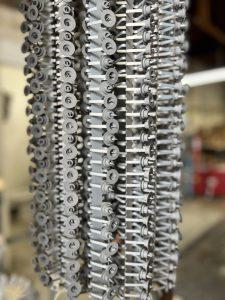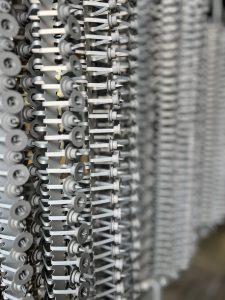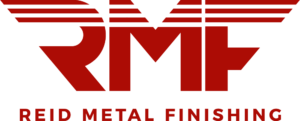Type 1 Anodizing
 Chromic acid (H2CrO4) forms the foundation of chromic anodizing. This anodizing treatment is often referred to as “Type I.” The chromic acid instrumental to Type I anodizing is less corrosive than the more aggressive sulfuric acid.
Chromic acid (H2CrO4) forms the foundation of chromic anodizing. This anodizing treatment is often referred to as “Type I.” The chromic acid instrumental to Type I anodizing is less corrosive than the more aggressive sulfuric acid.
Type I chromic anodizing is appropriate for complex and intricate parts since a critical step in any anodizing process is rinsing excess acid. With small and complex surface profiles, traces of acid may remain. These traces are not a big deal with chromic acid since they will not attack the component in question once chromic anodizing treatment is complete. This fact will ensure your part retains structural integrity and resilience to wear and tear and provides a surface for further paint treatment.
How chromic anodizing works
Chromic anodizing adds approximately 0.05mL to 0.1mL of coating on a given surface. The coating layer thickness approximates virtually zero for more significant parts treated with Type I chromic anodizing. Perhaps counterintuitively, a thinner layer is preferred to a thicker one when it comes to Type I anodizing. Although this is a rare circumstance, for exceptionally small, complex, or precise components, part design and manufacturing may need to consider the additional anodizing layer.
The benefits of Type I Anodizing
 Chromic anodizing helps tremendously with corrosion resistance. Despite being the thinnest coating treatment, Type I anodizing can provide corrosion protection on par with Type II or even Type III anodizing treatments.
Chromic anodizing helps tremendously with corrosion resistance. Despite being the thinnest coating treatment, Type I anodizing can provide corrosion protection on par with Type II or even Type III anodizing treatments.
Due to the thin yet resilient protection that Type I chromic anodizing affords, this treatment is used extensively in aluminum flight components subject to high mechanical stress. Landing gear comes to mind. Not only must landing gear repeatedly and reliably withstand the mechanical shocks and tension associated with their function, but also the varied temperature, salt, and moisture exposure that equipment, such as landing gear goes through. Chromic anodizing repels all those factors that would typically wear on aluminum parts.
Other components encounter unusual temperature extremes (as in/near propulsion systems) or constant exposure to salt water. Chromic anodizing can help with all of these concerns.
Reid Metal Finishing’s team is well-trained in chromic anodizing treatments. Be sure that your components will not encounter welding treatment, as that will negate many of the benefits chromic anodizing offers. Also, though chromic anodizing offers a surface for paint application, some colors and paints will appear sub-optimal. Stick to a black paint application for best results when dealing with chromic anodizing.
Inspection and replacement schedules are formulated, assuming that the parts in question are designed and reinforced up to a certain level of performance. We have enduring financial and technical assets to service chromic anodizing client needs at short notice.
Choose Reid Metal Finishing for your anodizing needs
Reid Metal Finishing has dedicated personnel, equipment, and quality checks that ensure your components are treated with chromic anodizing up to consistently high standards. Prospective military, firearms, and aerial/aerospace clients are highly encouraged to take a closer look at what Reid Metal Finishing can do for them.
